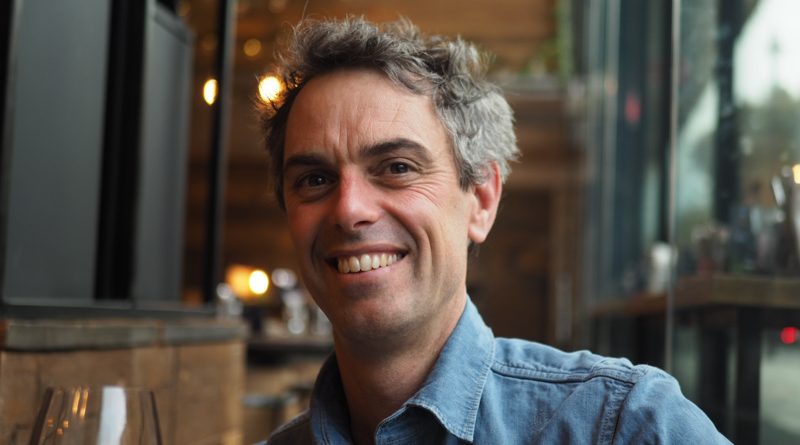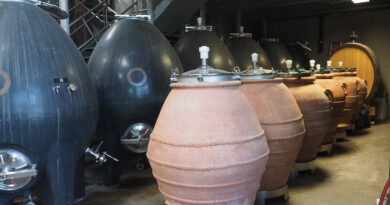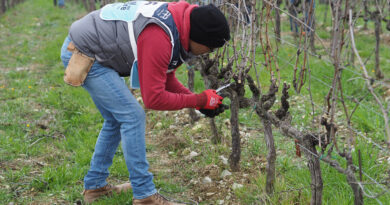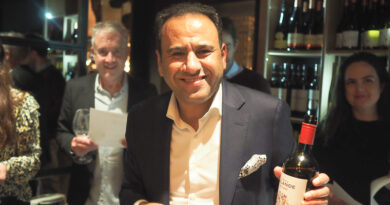Dom Maxwell of Greystone, the vineyard ferment guy
Jamie Goode catches up with Dom Maxwell, winemaker at Greystone in New Zealand’s Waipara wine region, to taste his wines and find out more about his innovative vineyard ferments
I meet Dom Maxwell on a Wednesday afternoon at Vagabond in Victoria. He’s over from New Zealand selling wine and meeting family. I’ve met him before in New Zealand a few times, and he’s emerging as one of the leaders of the unofficial interesting wine movement: people who are doing something a bit different, working with a bit less technology and intervention, looking to produce wines of place. Dom has really cemented his reputation through his innovative vineyard ferments, which are more than just a gimmick. More on them later.
Greystone are located up in the head of North Canterbury’s Waipara Valley, in the Omihi sub region. The altitude ranges from 60 m at the bottom with calcareous clay soils (seams of limestone start about six feet down), up the hill (it rises to 180 m), where you get more rocky outcrops and more limestone. Seismic activity has been important pushing things up here. There’s also sandstone influence on one side of the property. The vineyard was planted here in 2004.
Dom started here right at the beginning, after studying as a mature (age 26) student at Lincoln University studying viticulture and enology. Originally he did a commerce degree, and then worked in the UK. ‘I remember going to wine stores in London, and just enjoying the chat about this natural product that could become more interesting with time. I thought: someone has to make it,’ he recalls. ‘It was just a bit of luck that I got back to New Zealand when there were some opportunities.’ He started working at Greystone as a vineyard hand; they didn’t have a crop for three years. The first crop was tiny and he worked under consultant winemaker Alan McCorkindale (a respected Waipara pioneer) who advised them for the first vintage. ‘After that the owners of Greystone said OK, you do it now,’ says Dom. ‘So I had a lot of freedom from the early stages.’

They’ve changed how they do things over time. The first job was to make clean wines, so they inoculated. Gradually they have moved towards organics and natural ferments. They also farm organically now.
I suggested that New Zealand has often seemed to play it quite safe rather than seek to work on the margins. Is this changing? ‘Yes, you’d think it would be perfect for it,’ he responds. ‘We have smaller regions, we are pretty lucky with the weather.’ He says that they have given up entering competitions in New Zealand.
‘This is the patch of soil we have. We are the only people with this. If we make it relatively hands off, then we are going to make wine that is unique to us, and then we’ll find our people.’
The wine that Dom has become famous for is his vineyard ferment Pinot Noir. How did this come about?
I was driving around the vineyard with Nick Gill, who I’ve worked with from the start. This is back in 2013, just before harvest, and I said I wouldn’t mind fermenting something in the vineyard this year. He said, sounds good, what do you need to make it happen? Some pallets and access to a tractor. The idea was that we’ve been fermenting everything with natural yeast, but when we moved to Muddy Water [the sister property where they now make the wines] I noticed that our Pinot Noir ferments were different. Some people were using pied de cuves and there was a bit of chat locally about the need to get your vineyard yeast into the ferment. I was thinking about it, and though, you’ll still be bringing it into the winery, and depending on what’s happened in the winery in the past how will you really know? We figured, it’s worth a go. We fermented 700 kg the first year, and it took about 12 days to kick off. It was a cold part of vintage. Immediately, the first fork in the road popped up: it’s not all about the yeast when you are fermenting out there: there’s also the weather. We really liked the wine. It was quite dark because of all that cold soak, but we carried on. Every vintage has been different, and the weather has played quite a big part. There have been years when batches of fruit have been picked at 20 C and they have been fermenting by the next morning. Ordinarily, the trained winemaker in me would freak out. But when you look at those wines later on, they are beautiful. We taste them in the cellar and compare them with our traditionally made Pinot Noir, which has had a four-day cold soak and has been plunged twice a day, and we see the fineness and the detail of the vineyard ferments. There are still a lot of questions for us around the microbial population. We have just started a three-year research program with a PhD student from Lincoln University. She is in the middle of analysing about 300 samples we took over harvest, comparing the same fruit fermenting in the vineyard and the winery.
Dom Maxwell, talking about his vineyard ferment Pinot Noir
The grapes were initially processed in the winery and then taken out to the vineyards. But they have now purchased a single-phase destemmer and they can process everything in the vineyard. ‘We pick into buckets, they go onto the back of a quad bike, which drives up to the fermented with the destemmer sitting on top of it hooked up to a generator.’ The goal of the research project is to look at the microbial population in the soils and vines, and how this relates to what is in the fermenter.
Is anyone else doing this now? ‘Yes. Aliastair Maling came over to me at a tasting and showed me a photo of them at Te Kairanga [Martinborough] with a vineyard fermenter, says Dom. Helen Morrison has been doing some whole-bunch Sauvignon in the vineyard at Villa Maria in Marlborough. Amisfield in Central Otago are doing some too. And someone who worked with Dom is making Sangiovese in the vineyard in Tuscany.
‘I have learned so much from this process,’ says Dom. As a result of what they have learned in the vineyard ferments, ‘we’ve gradually pulled our foot off in the winery, and our whole approach has changed.’
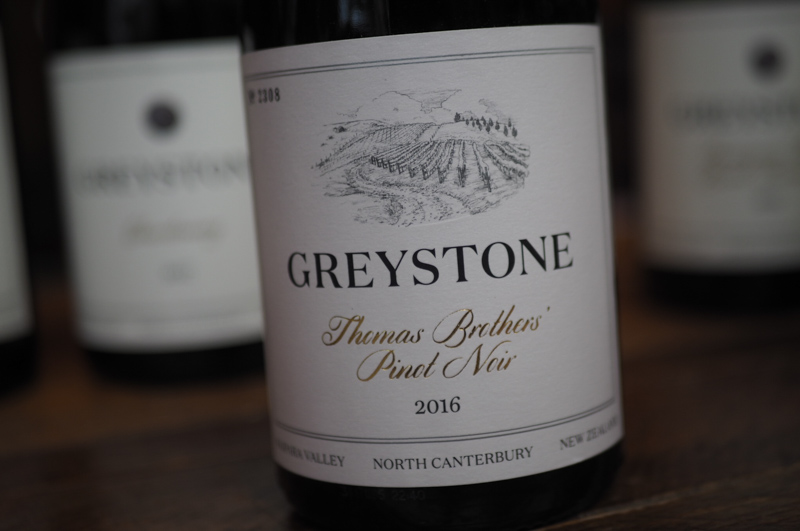
THE WINES
Greystone Sand Dollar Pinot Gris 2018 Waipara, New Zealand
Single-block. Used to make two styles, but now just making one. A generous vintage. 8.5 tons/ha which is quite large. Winemaking is partial barrel (10%), then tank, fermented to dryness. Chilled, left on lees without sulfur. Blend in the oak portion. Lovely pear and peach fruit with some table grape notes. Nicely textured with some flavour. Has generosity. 91/100
Greystone Sauvignon Blanc Barrel Fermented 2018 Waipara, New Zealand
Mainly 530 and 376 clones. Generally around 7-7.5 ton/ha, which is 2 t/ha less than they’d get with MS1 here. All old barrel, long fermentation (typically bottling after 7 months in barrel). Complex nose of honey and nuts with fine spices. Have a bit of natural malolactic happening which adds texture. Has some honey and spice with a bit of fig. Lovely wine: complex and alive. Some apple on the finish. 93/100
Greystone Chardonnay 2017 Waipara, New Zealand
From three blocks. The Saddle was Syrah and swapped over to Chardonnay five years ago, and only had a little. The Erin is on limestone, and there’s also a clay block near the cellar door. Lovely richness and toastiness here with spice, peach, pear and some mineral notes. Opulent, rich and harmonious. This has everything: a really complete with richness and also focus. 94/100
Greystone Pinot Noir 2016 Waipara, New Zealand
All from hillsides, the majority clay over limestone, a mixture of clones. Ferment sizes 1.5-4 tons. This is 10% whole bunch, something that is increasing overall. Fresh, balanced and quite restrained, with a nice savoury edge to the cherry and plum fruit. From a warmer than average yield, but the wines kept their acidity. Juicy and linear with a nice sour cherry edge and good freshness. This has lovely balance and focus. 93/100
Greystone Vineyard Ferment Pinot Noir 2017 Waipara, New Zealand
Wonderfully expressive peppery nose with sweet red cherries, some herbs and some earth. The palate has incredible tension and delicacy, with lovely sour cherry, fine herbs, red cherry and some plums. This is so beautiful and expressive with lovely detail and savoury interest. Such precision to this wine. Floral and fine. 96/100
Greystone Thomas Brothers Pinot Noir 2016 Waipara, New Zealand
Single block Pinot from the most limestone dominated bit. More of a traditional approach. 20% whole bunch. 15-16 months in barrel. This is powerful, with lovely freshness and a nice acid line. Has great focus with nice acidity and concentrated berry and cherry fruit. Layers of flavour here with great length. Nice savoury twist on the finish, which as a hint of sourness, but in a nice way. Lovely. 95/100
Find these wines with wine-searcher.com

